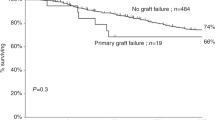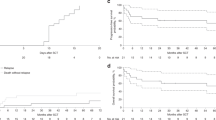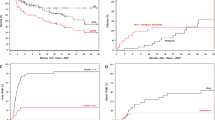Summary:
Allogeneic SCT for myeloma may be curative for young patients, but its role remains controversial because of a reported high TRM in some series. Since 1991, we have performed 25 allografts for myeloma using fully matched sibling donors. Of the 18 evaluable patients, 13 achieved CR at a median time of 2.5 months post-transplant. The five patients who were not in CR when assessed at 3 months received a short course of α-interferon and four subsequently achieved CR with this approach at a median of 82 days. One patient who failed to respond to IFN went on to achieve CR after four doses of DLI therapy, thus giving an overall CR rate of 72%. Seven patients have relapsed at a median of 4.7 years post-transplant (range 1.38–7.7 years) including two patients who had received IFN therapy. In five of these cases, relapse has been as a localised area of bone disease or isolated plasmacytoma with no evidence of marrow involvement by trephine biopsy or molecular analysis. All patients with localised relapse were treated with local radiotherapy ±DLI and four are currently disease free despite two patients having had further treatment for a second localised lesion. Six patients died of TRM (24%) and the OS at 8 years is currently 69% with an EFS of 26%. These results suggest that allogeneic SCT for myeloma can be carried out with an acceptable TRM and a high CR rate. However, late relapses as localised disease may be a frequent finding and may represent foci of myeloma not eradicated by the conditioning. The use of pretransplant MRI scanning and top-up radiotherapy to involved areas may be useful in preventing this type of relapse.
This is a preview of subscription content, access via your institution
Access options
Subscribe to this journal
Receive 12 print issues and online access
$259.00 per year
only $21.58 per issue
Buy this article
- Purchase on Springer Link
- Instant access to full article PDF
Prices may be subject to local taxes which are calculated during checkout




Similar content being viewed by others
References
Gahrton G, Ture S, Ljungman P et al. Prognostic factors in allogeneic bone marrow transplantation for multiple myeloma. J Clin Oncol 1995; 13: 1312–1322.
Bjorkstrand B, Ljungman P, Svensson H et al. Allogeneic bone marrow transplantation versus autologous stem cell transplantation in multiple myeloma: a retrospective case-matched study from the European group for Blood and Marrow Transplantation. Blood 1996; 88: 4711–4718.
Gahrton G, Svensson H, Cavo M et al. Progress in allogeneic bone marrow and peripheral blood transplantation for multiple myeloma: a comparison between transplants performed 1983–1993 and 1994–1998 at European Group for Blood and Marrow Transplantation Centres. Br J Haematol 2001; 113: 209–216.
Rosler W, Strobel G, Sendler A et al. Relapse of light chain myeloma after allogeneic transplantation: no recurrence of myeloma protein. Bone Marrow Transplant 1996; 17 (S1): 329a.
Bertz H, Burger J, Kinzmann R et al. Adoptive immunotherapy for relapsed multiple myeloma after allogeneic bone marrow transplantation (BMT): evidence for a graft-versus-myeloma effect. Leukemia 1997; 11: 281–283.
Zomas A, Stefanoudaki K, Fisfis M et al. Graft-versus-myeloma after donor leukocyte infusion: maintenance of marrow remission but extramedullary relapse with plasmacytomas. Bone Marrow Transplant 1998; 21: 1163–1165.
Trullemans F, Schots R, Storme G et al. Late and localised extramedullary relapse of a light chain kappa myeloma after syngeneic bone marrow transplantation. Bone Marrow Transplant 2000; 25: 115–117.
Chong G, Byrnes G, Szer J, Grigg A . Extramedullary relapse after allogeneic bone marrow transplantation for haematological malignancy. Bone Marrow Transplant 2000; 26: 1011–1015.
Biagi J, Mileshkin L, Grigg A et al. Efficacy of thalidomide therapy for extramedullary relapse of myeloma following allogeneic transplantation. Bone Marrow Transplant 2001; 28: 1145–1150.
Russell NH, Miflin G, Stainer C et al. Allogeneic bone marrow transplantation for multiple myeloma. Blood 1997; 89: 2610–2611.
Russell NH, Bessell EM, Stainer C et al. Allogeneic haemopoietic stem cell transplantation for multiple myeloma or plasma cell leukaemia using fractionated total body radiation and high dose melphalan conditioning. Acta Oncologica 2000; 39: 837–841.
Byrne JL, Carter GI, Bienz N et al. Adjuvant a-interferon improves complete remission rates following allogeneic transplantation for multiple myeloma. Bone Marrow Transplant 1998; 22: 639–643.
Blade J, Samson D, Reece D et al. Criteria for evaluating disease response and progression in multiple myeloma treated with high dose chemotherapy and haemopoietic stem cell transplantation. Myeloma subcommittee of the EBMT. Br J Haematol 1998; 102: 1115–1123.
Goldman J, Apperley J, Jones L et al. Bone marrow transplantation for patients with chronic myeloid leukemia. N Engl J Med 1986; 314: 202–207.
Mortimer J, Blinder MA, Schulman S et al. Relapse of acute leukemia after marrow transplantation: natural history and results of subsequent therapy. J Clin Oncol 1989; 7: 50–57.
Frassoni F, Labopin M, Gluckman E et al. Are patients with acute leukaemia alive and well 2 years post bone marrow transplantation cured? A European survey on behalf of the European Group for Bone Marrow Transplantation (EBMT). Leukemia 1994; 8: 924–928.
Author information
Authors and Affiliations
Rights and permissions
About this article
Cite this article
Byrne, J., Fairbairn, J., Davy, B. et al. Allogeneic transplantation for multiple myeloma: late relapse may occur as localised lytic lesion/plasmacytoma despite ongoing molecular remission. Bone Marrow Transplant 31, 157–161 (2003). https://doi.org/10.1038/sj.bmt.1703810
Received:
Accepted:
Published:
Issue Date:
DOI: https://doi.org/10.1038/sj.bmt.1703810



